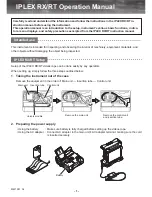
January 2006
3-10
Operation
Sensor Balancing
During normal operation, the sensor mirror surface may become
partially obscured with salts or other contaminants from the sample
gas. The balance indicator displayed on the screen shows whether the
system is operating near the center of its normal range, or has been
forced away from the center by mirror contamination. In general, it is
recommended to start with an AUTO balance cycle provided
relatively clean gases are being used. If the Service status indicator is
displayed after an AUTO cycle, the mirror is likely still dirty and may
require use of a PACER cycle (described in detail on page 1-6). In
most applications, it is desirable to perform a balance operation
periodically to maintain optimum performance. The interval and type
of balance are configurable as described in chapters on Optica
programming.
If the Service indicator is displayed after a balance operation, the
sensor may need to be adjusted (see
Balancing the Sensor Optics
on
Helpful Hints For
Operating the Unit
Time response At dew points above 0°C, the system stabilizes within
a few minutes at a consistent dew layer. The status
Control
is
displayed when the system is stable and readings are valid.
When the system is operating at low frost points (below –40°C), extra
care may be required when interpreting readings because of the
longer response times of the system. Time response depends on a
number of factors including dew/frost point, slew rate, upstream
filtering, and flow rate.
•
As the dew/frost point becomes lower, water molecules in the air
sample become scarcer, and it takes longer to condense a frost
layer on the mirror thick enough to establish an equilibrium
condition.
•
Mirror temperature slew rate depends on dew point and depression
(the temperature difference between the mirror and the sensor
body); at higher dew points and moderate depressions, it is
typically 1.5°C/second. At lower dew points and/or larger
depressions, the slew rate is slower.
•
Flow rate affects response by determining the rate at which water
vapor is supplied or carried off.
There is, of course, a trade-off between response time, control system
stability, and sensitivity to contamination.
Summary of Contents for Optica
Page 1: ...GE Sensing Optica General Eastern Dew Point Analyzer Operator s Manual ...
Page 11: ...Chapter 1 ...
Page 20: ...Chapter 2 ...
Page 43: ...Chapter 3 ...
Page 58: ...Chapter 4 ...
Page 80: ...Chapter 5 ...
Page 94: ...Chapter 6 ...
Page 95: ...Network Based Programming Introduction 6 1 Programming Screens 6 1 ...
Page 99: ...Chapter 7 ...
Page 109: ...Appendix A ...
Page 114: ...Appendix B ...
Page 115: ...Humidity Equations and Conversion Chart Introduction B 1 Vapor Pressure B 1 Humidity B 2 ...
Page 119: ...Appendix C ...
Page 120: ...Configuring the Serial Interface Wiring to a Personal Computer C 1 ...
Page 122: ...Appendix D ...
Page 127: ...Appendix E ...
Page 128: ...Glossary ...
Page 130: ...Appendix F ...
Page 133: ...Appendix G ...
















































